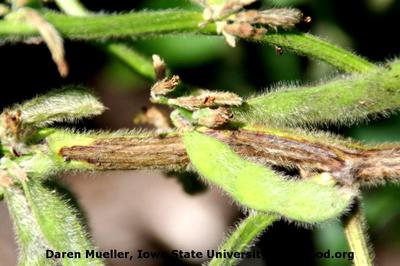Northern Stem Canker
Diaporthe caulivora
Fungus
In a Nutshell
- Reddish-brown lesions at the base of lower branches and leaf petioles.
- Elongated dark-brown cankers surround the stem.
- Impaired flow of water and nutrients in the plant results in interveinal chlorosis of leaves.
- Leaves affected by the lesions die but remain attached to stem.
Can also be found in
Symptoms
Initial symptoms appear as small reddish-brown lesions at the base of branches and leaf petioles in the lower part of the plant. The lesions later extend up and down the stem and turn dark-brown. The alternate pattern of green and brown patches along the stem characterizes the disease. The canker damages the internal tissues of the stem and hinders the transport of water and nutrients. Interveinal chlorosis appears on leaves. The leaves might die later but remain attached to the stem. Plant parts above the lesions may die and podding is severely compromised.
Recommendations

Organic Control
If available, an integrated approach with biological fungicides is recommended.

Chemical Control
Always consider an integrated approach with preventive measures together with biological treatments if available. Fungicide treatments may help to control the infection but results differ widely depending on time of application, environmental conditions and products used. If necessary, apply products containing mefenoxam, chlorothalonil, thiophanate-methyl or azoxystrobin during vegetative and reproductive growth stages
What caused it?
Soybean stem canker is caused by the soilborne fungus Diaporthe phaseolorum. There are two slightly different variants of the fungus causing southern and northern stem cankers. It overwinters in infested crop residues or on seeds.It infects plants early in the vegetative stage but symptoms become apparent only during the reproductive stage. Persistent wet and rainy weather conditions, in particular early in the season, favor the infection. Poor tillage practices might be favorable, too.
Preventive Measures
- Plant tolerant or resistant varieties.
- Use certified pathogen-free seeding material.
- Plant later in the season.
- Maintain good soil fertility with balanced nutrition.
- Rotate with non-host crops such as corn, wheat, sorghum for at least two years.
- Avoid excessive weed growth near your cultures.
- Harvest as soon as possible to avoid wet periods.
- Plow the field to expose the soil to solar radiation and wind.
- Bury infected crop residues after harvest.



